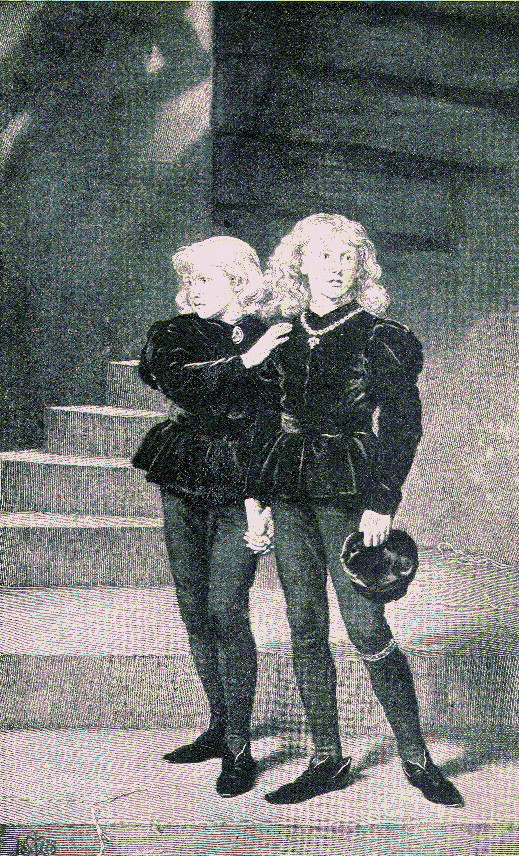Story of the English - Helene Guerber |
The Princes in the Tower
Before Edward IV. died, he foresaw that there might be trouble between his brother Richard and his wife's kindred, so he used his last breath to implore them to be friends. As soon as he was dead, two of the queen's relatives, Earl Rivers and Lord Grey, took charge of Edward V., the eldest son and successor of the king, while the queen withdrew into a sanctuary with her other children. Edward V. was on his way to be crowned at London, when his uncle Richard, Duke of Gloucester, came to meet him. During the first day's journey all went well, but on the second day Richard suddenly had Rivers and Grey seized by his guards. They were then dragged off to prison in spite of the little king's entreaties.
Having thus got rid of the queen's relatives, Richard, whose plan was to secure the throne for himself, led the little king to the Tower, where he was to stay until his coronation. Then, calling Parliament, Richard got from it the title of Protector, for Edward was too young to reign alone.
A few days later, Richard suddenly accused Lord Hastings, a friend of the late king, of treason. In proof, he showed his deformed arm, and told the assembled council that its shrunken appearance was due to the witchcraft of Hastings's friends. Now every one knew that this was not true, but no one dared oppose Richard. He therefore called the guards, and bade them immediately behead Lord Hastings, adding that he would not dine until he knew the traitor was dead.
The guards obeyed, and Lord Hastings was beheaded in the courtyard, on a convenient log of wood, without any further trial. Then some guards were sent off to Pontefract Castle, where Rivers and Grey were put to death, under the pretext that they also were traitors.
Thus rid of the men who would have been most likely to oppose him, Richard, still pretending that he was devoted to the little king, sent for the latter's brother, Richard, Duke of York. The queen hated to let her second son go, but he joyfully entered the Tower to join his brother. As Richard now had both of these princes in his power, he made his friend Buckingham tell the people that they were not the dead king's own offspring, and that he, Richard of Gloucester, ought to be king.
Buckingham managed so cleverly that he persuaded a few persons to go and offer the crown to Richard. The latter pretended at first to be shocked and surprised; but finally he accepted the crown and the title of Richard III. Still, although he had a grand coronation feast, he felt that he should never be safe so long as his brother's sons were alive; so he resolved to put them to death.
Two murderers were therefore sent to the Tower, bearing an order to the governor, who was forced to give up his keys to them for one night. When the governor came back the next day, he rushed to the princes' room, but found it empty. A few days later it became generally known that the little princes were no more; but it was only after Richard's death that it was discovered how they had been killed.
 THE PRINCES IN THE TOWER. |
It was then reported that the murderers, finding them asleep on their bed, clasped in each other's arms and with their prayer book beside them, smothered them under a big feather bed. Then they took the bodies and secretly buried them under one of the Tower staircases. Two hundred years later, a mason, in repairing some broken steps, found the bones of two children, and everybody now believes that they were those of the murdered princes.